A BIRTHDAY TRIBUTE to Levitz, who turns 68!
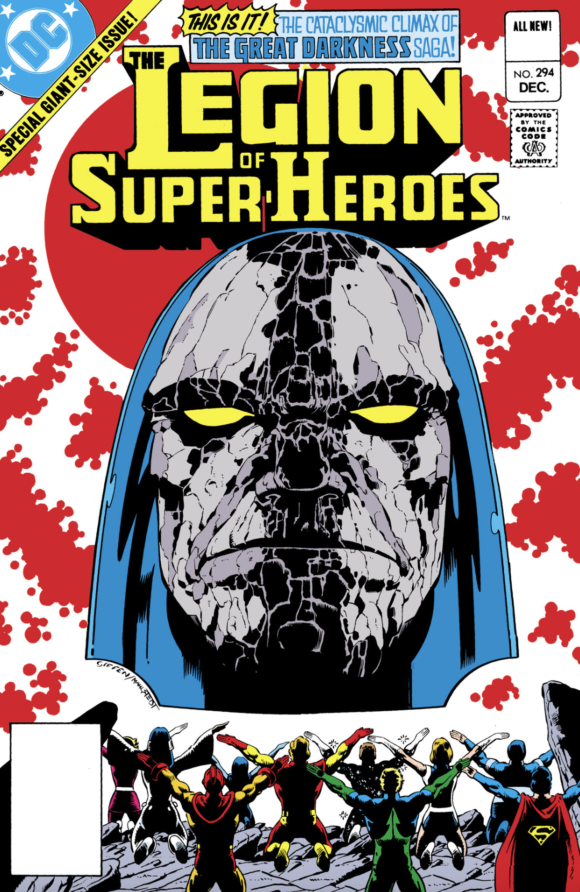
—
UPDATED 10/21/24: Paul Levitz turns 68! Perfect time to reprint this piece from 2019, in slightly altered form. By the way, there’s a new paperback edition of The Great Darkness Saga out now (click here) — and a new deluxe edition hardcover due in March 2025! (Click here.) Dig it! — Dan
—
Longtime Legion of Super-Heroes are relieved — and a little anxious — that DC is finally bringing back their fave superhero team this September.
Makes sense. The team hasn’t fared well for a long time and old-school fans are often suspicious of what new creators — in this case writer Brian Michael Bendis — will bring to the Clubhouse.
So time will tell.
And it’s all about time, when it comes to the Legion, isn’t it? So let’s look back at when the team was at its zenith — when it was a creative and commercial smash: the 1980s.
Now, a bit of a side note here:
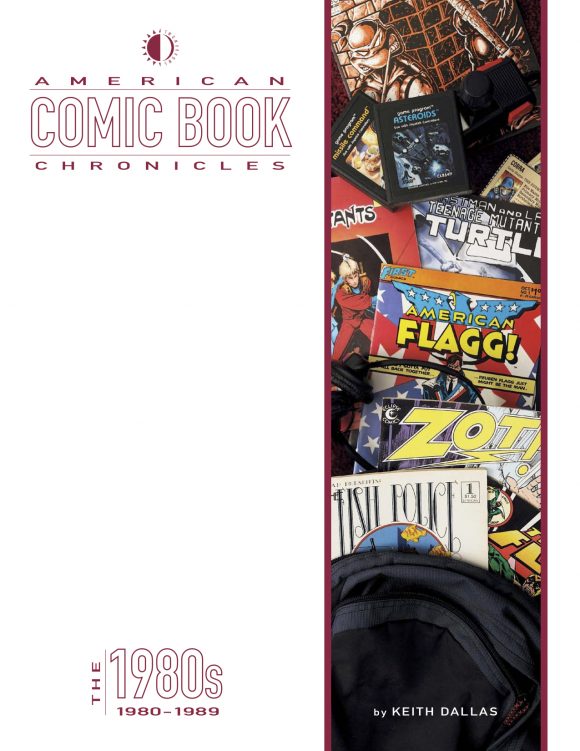
The article below is an excerpt from TwoMorrows’ American Comic Book Chronicles: The 1980s, by Keith Dallas and a coterie of contributors, including 13th Dimension favorites Jim Beard and Bill Walko, who designed the book, which you can order directly through the publisher.
Here’s the table of contents:
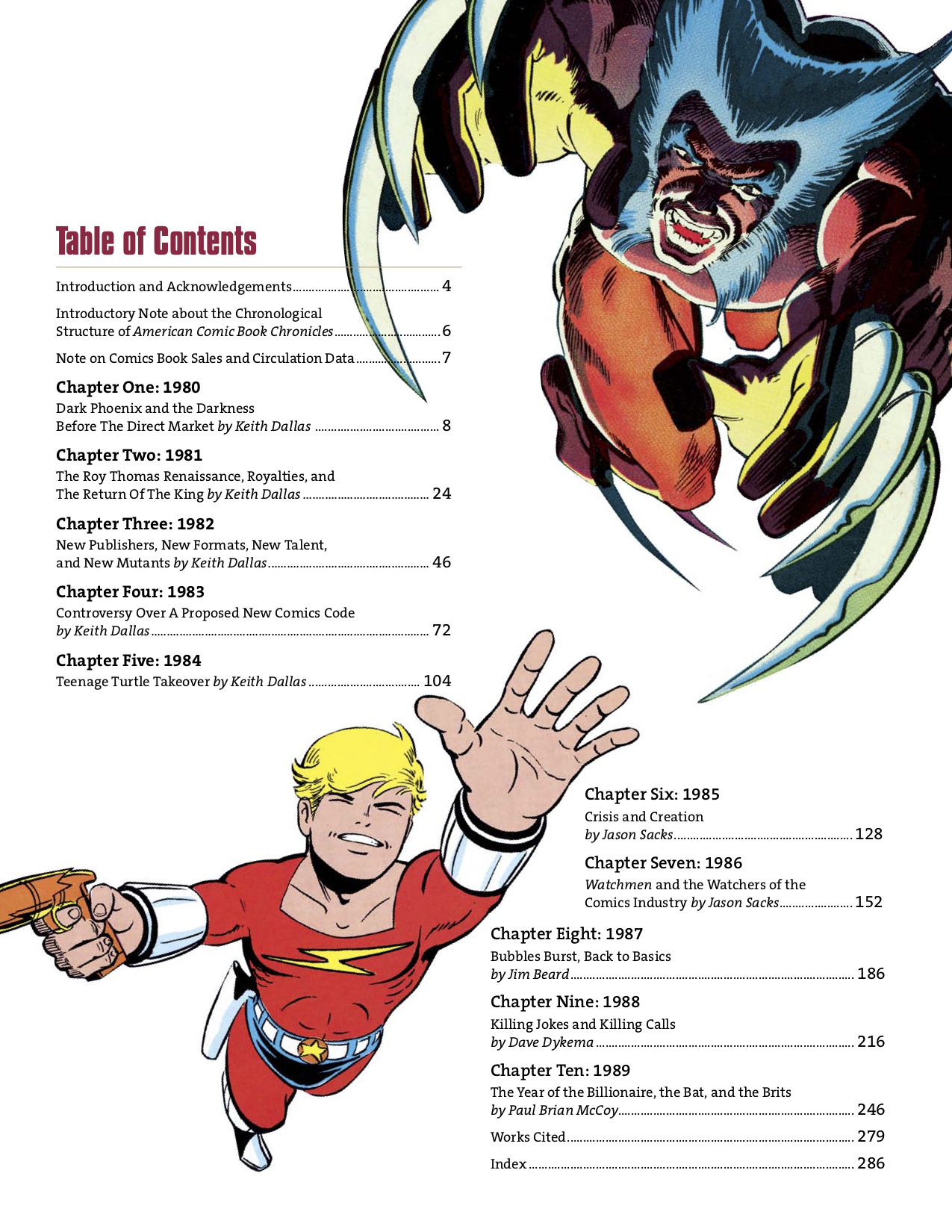
But back to the Legion — and a look at the team’s peak, when Paul Levitz and Keith Giffen joined forces for a classic run highlighted by The Great Darkness Saga:
—
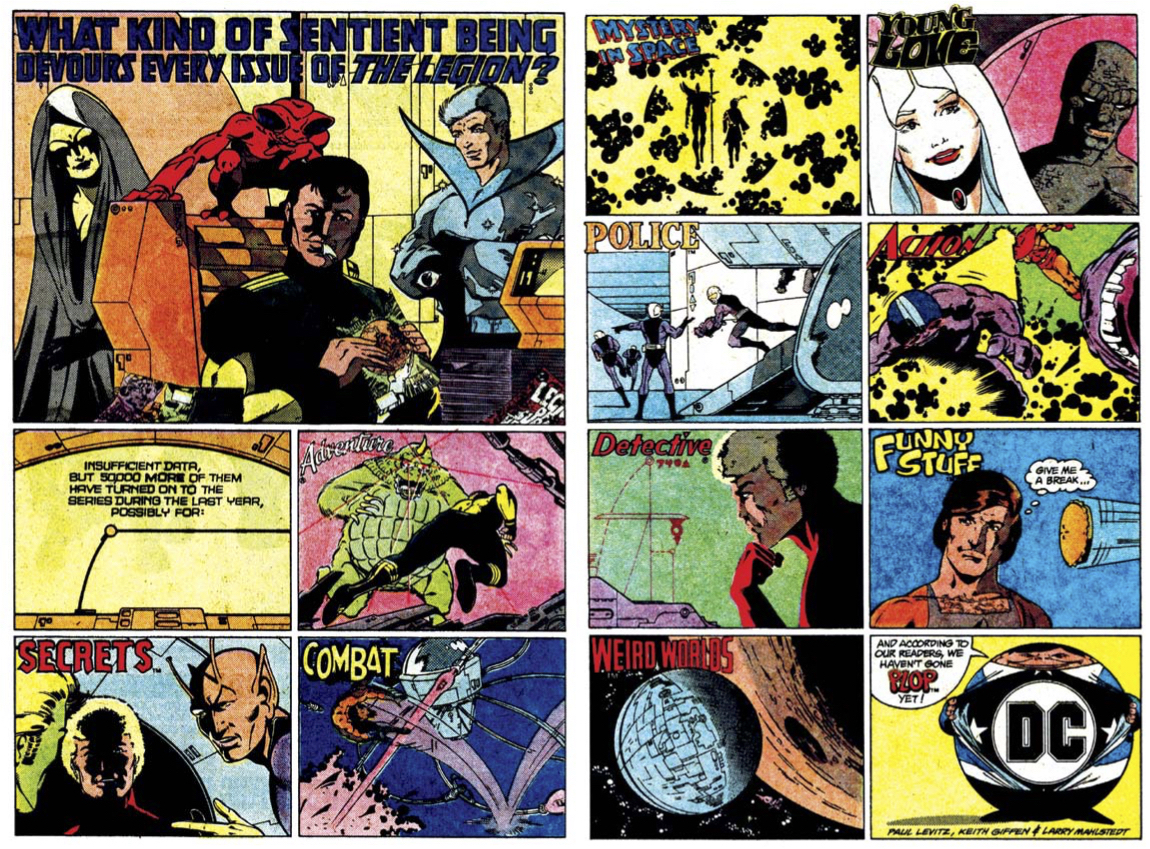
By KEITH DALLAS
While Paul Levitz’s climb up DC’s corporate ladder was a considerable achievement in and of itself, his name would soon become inexorably associated with a different task he performed for DC Comics: writing The Legion of Super-Heroes.
With Legion of Super-Heroes #284 (Feb. 1982), Levitz relieved Roy Thomas as the title’s scribe. This was Levitz’s second go-round with DC’s “teens from tomorrow”; he previously scripted Superboy and the Legion of Super-Heroes between 1977 and 1979.
Truth be told, the Legion wasn’t a much sought after professional assignment. With over two dozen main characters to keep track of, writing — or drawing — the Legion of Super-Heroes amounted to a daunting undertaking. What’s more, the general consensus amongst fandom was that the Legion was DC’s most puerile of superhero team offerings, much less mature than the Justice League of America or The New Teen Titans.
And even for comic book fans, the Legion devotees were regarded as peculiar, with their preoccupation on costumes and alien cultures and other seeming minutiae of the series. Consider this fan letter printed in Comics Scene #6 (Nov. 1982): “I feel rather sorry for… the pathetic ‘thousands’ of fans of the Legion of Super-Heroes, because try as I might, I cannot understand anyone liking, much less following, this series of inept beach bums through padded and inane plots of adolescent banality!”
Neither the prospect of labor-intensive writing nor the lack of fan appreciation affected Levitz though; his love of the Legion of Super-Heroes dated back to his childhood. So when Legion editor Mike Barr invited him to return to the title, Levitz quickly accepted and he sought to make The Legion of Super-Heroes more “new reader friendly.”
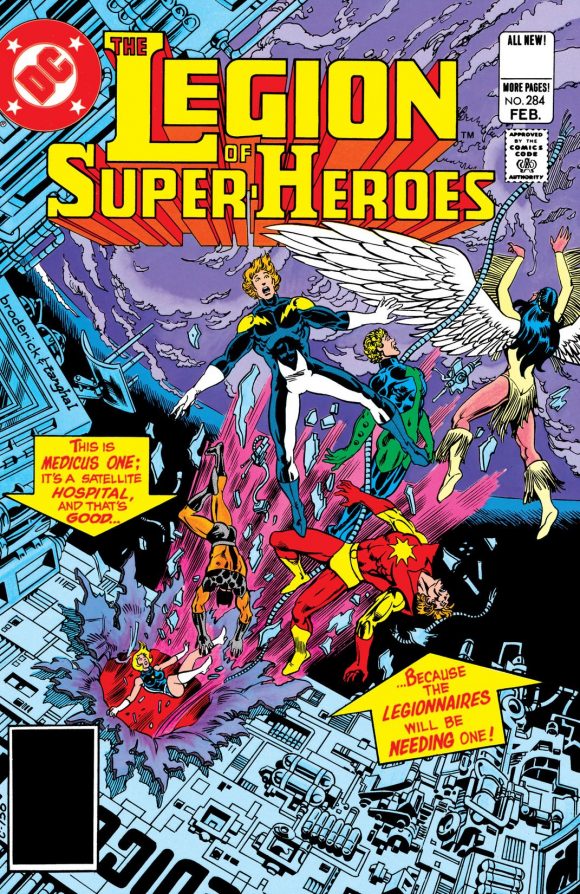
Pat Broderick pencils, Romeo Tanghal inks
In 1982, the Legion could be found in an array of DC Comics publications. They guest starred in DC Comics Presents #43 (March 1982) and World’s Finest Comics #284 (Oct. 1982). With its relaunch as a digest with Issue #491 (Sept. 1982), Adventure Comics began reprinting the earliest adventures of the Legion in chronological order, starting with their introductory appearance in 1958’s Adventure Comics #247.
Finally, the Best of DC #24 digest (May 1982) not only offered a new Legion tale — written by Levitz and drawn by Carmine Infantino — it also presented a 16-page George Pérez Legion of Super-Heroes gallery.
But the elevated visibility of DC’s super-teens from the 30th century wasn’t the cause of the Legion’s newfound popularity. Instead, the catalyst for the team’s success was the unique creative collaboration between Levitz and the Legion’s new artist, Keith Giffen.
By 1982, Keith Giffen was looking to atone for the professional sins he committed only a few years earlier. He began his career at Marvel in 1976. That same year Gerry Conway — then a DC Comics editor—hired Giffen to draw breakdowns for Wally Wood on All-Star Comics. That led to other assignments from both DC and Marvel like The Defenders, Challengers of the Unknown, and Claw the Unconquered.
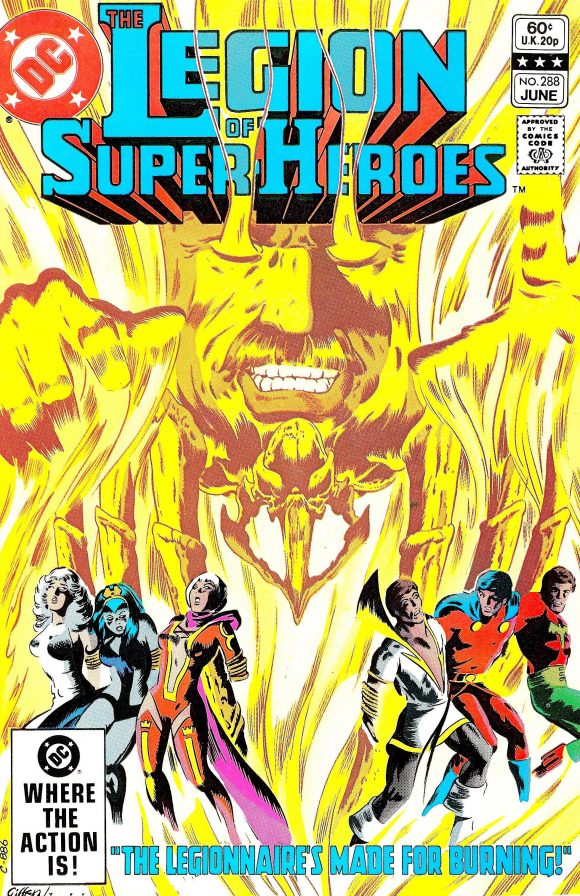
Keith Giffen pencils, Tanghal inks
But Giffen was unreliable and erratic, and in 1978 he simply left the industry, abandoning projects without notice. After a period of living in New Jersey as a repo man and selling vacuum cleaners door-to-door, Giffen approached Joe Orlando in 1980 to see if Orlando would give him a second chance at DC.
Orlando did, but he effectively put Giffen on probation. After first drawing a few horror stories for Dick Giordano, Giffen proved himself and Mike Barr offered him two ongoing assignments for 1982: the Dr. Fate back-up feature in The Flash and The Legion of Super-Heroes.
Giffen’s tenure on Legion actually began with a back-up story featuring Dream Girl in Issue #285 (March 1982). With Issue #287, Giffen had replaced Pat Broderick as the title’s regular penciller, and what he made immediately clear was that he was going to let his imagination run wild for the book’s visuals.
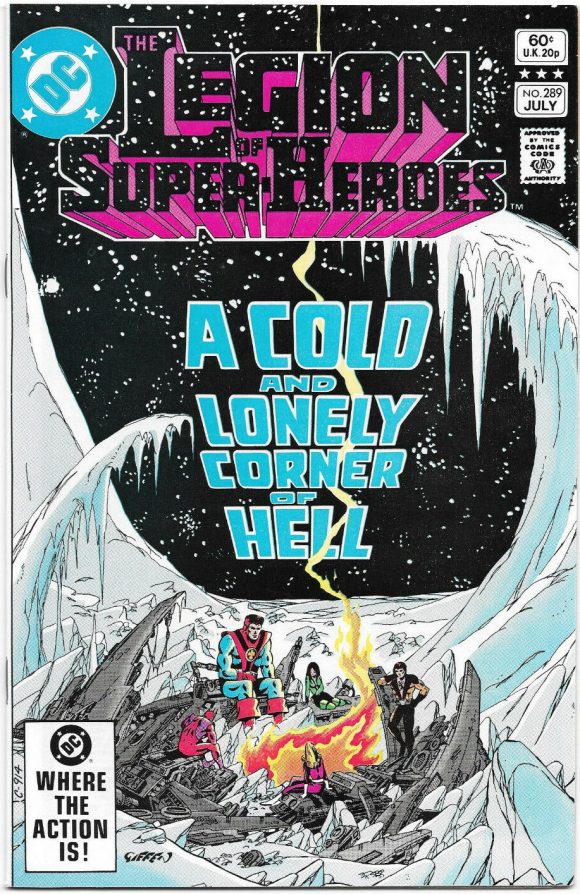
Giffen
With a style evocative of Jim Starlin as filtered through George Pérez, Giffen created a futuristic universe filled with bizarre aliens, astounding architecture, and intricately designed machinery and gadgets. As he drew pages that often had more than seven panels — and on occasion 11 or 12 panels — Giffen committed himself to depicting a future so technologically evolved as to be almost unfathomable to the comic book reader of 1982. Or put more simply by Giffen, “In the Thirtieth Century, if it’s got wheels, it’s wrong!”
Levitz and Giffen embodied contrasting creative processes. Levitz described himself as the “linear, literal” storyteller, but Giffen was the “unrestrained, creative thinker.” Put together, the methodical writer and the free spirited artist found their opposing tendencies weren’t at odds with each other. Instead, Giffen’s imagination infused Levitz’s intricately laid out plots. By doing so, they made each other better creators, and they went on to produce a nearly three-year-long collaboration that many consider to be the standard by which all other Legion of Super-Heroes eras are judged.
And the most celebrated story of the Levitz/Giffen Legion run came near the beginning of their collaboration: The Great Darkness Saga.
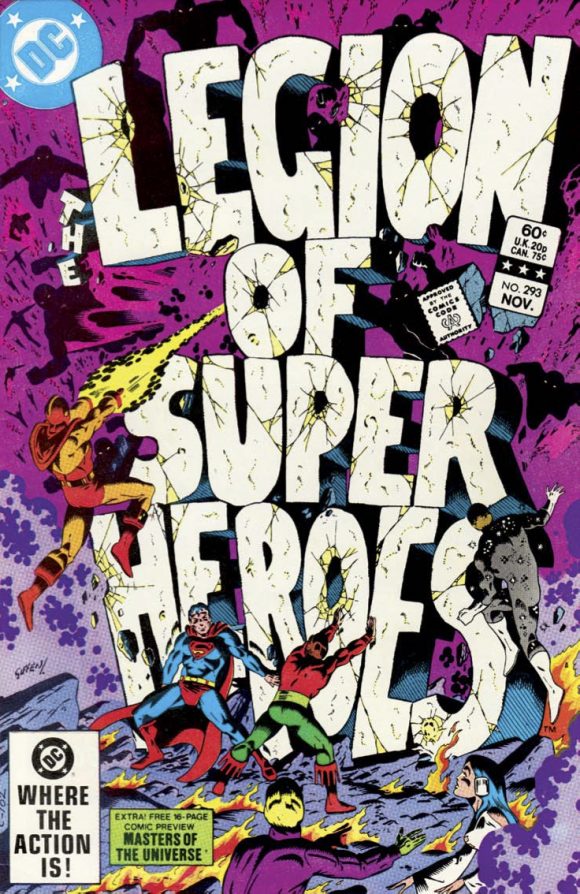
Giffen
Legion of Super-Heroes #289 (July 1982) bills The Great Darkness Saga as “The Most Monumental Battle-Epic the Legion Annals Have Ever Recorded!” That wasn’t empty hype. The story begins with super-powered “Servants of Darkness” seeking out magical artifacts for their mysterious master. Even with Superboy’s help, the Legion proves to be little match against these servants. The conflict’s stakes escalate with the shadowy villain boasting he is des- tined to reign over all the cosmos, and at the end of the penultimate chapter, he stands revealed. The Legionnaires find them selves up against none other than… Darkseid.
For those who first read The Great Darkness Saga when it was collected into a trade paperback, the appearance of the ruler of Apo- kolips came as no surprise; he’s featured on the TPB cover. But those who read The Great Darkness Saga as a monthly serial in 1982 were treated to a jaw-dropping reveal. Darkseid had never before confronted the Legion of Super-Heroes, and readers were more accustomed to seeing one of Jack Kirby’s finest creations fight the New Gods, Superman, the Justice League, and the combined forces of the Uncanny X-Men and New Teen Titans in the late summer 1982 Marvel/DC crossover special.
Darkseid’s appearance in Legion of Super-Heroes was a plot development few readers could have anticipated, which is one reason why The Great Darkness Saga made such an impression.
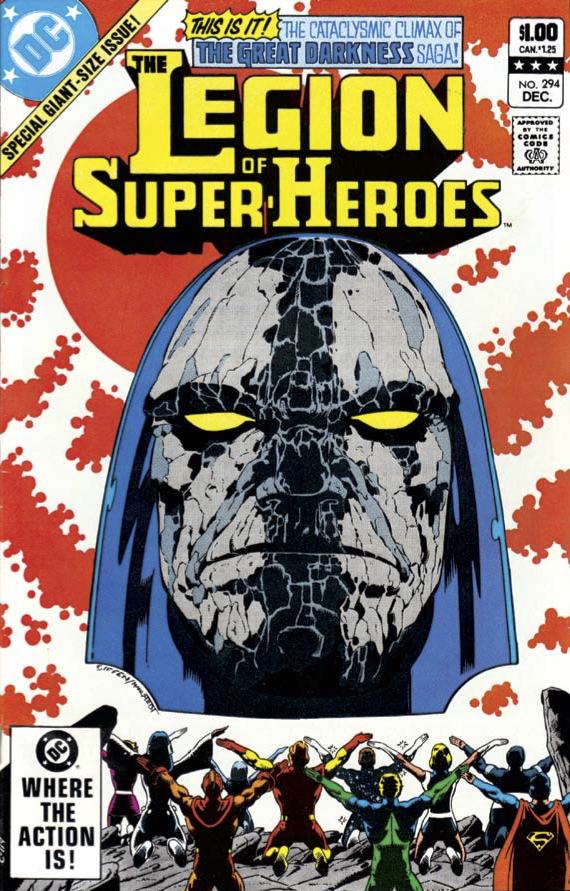
Giffen pencils, Larry Mahlstedt inks
The story concluded in Legion of Super-Heroes #294 (Dec. 1982), a 41-page issue priced at a dollar, featuring not only every Legionnaire — and again, there are a lot of them — but also practically every supporting character in the history of the team: Superboy, Supergirl, Legion of Substitute Heroes, Wanderers, among many others. Their combined might forces Darkseid’s retreat, but not before he places a curse on the Legion, prophesying the team’s self-destruction.
As a publication though, Legion of Super-Heroes was anything but cursed. In the aftermath of The Great Darkness Saga, the series quickly became DC’s second best-selling title with only New Teen Titans above it.
The two titles would remain DC’s top two sellers for the next three years, but being second best was no consolation to Giffen as he confessed many years later, “Oh, I wanted to knock [New Teen Titans] off #1 so bad back then! We were always chasing them, and I wanted to just get one month where we could just knock them off the perch.”
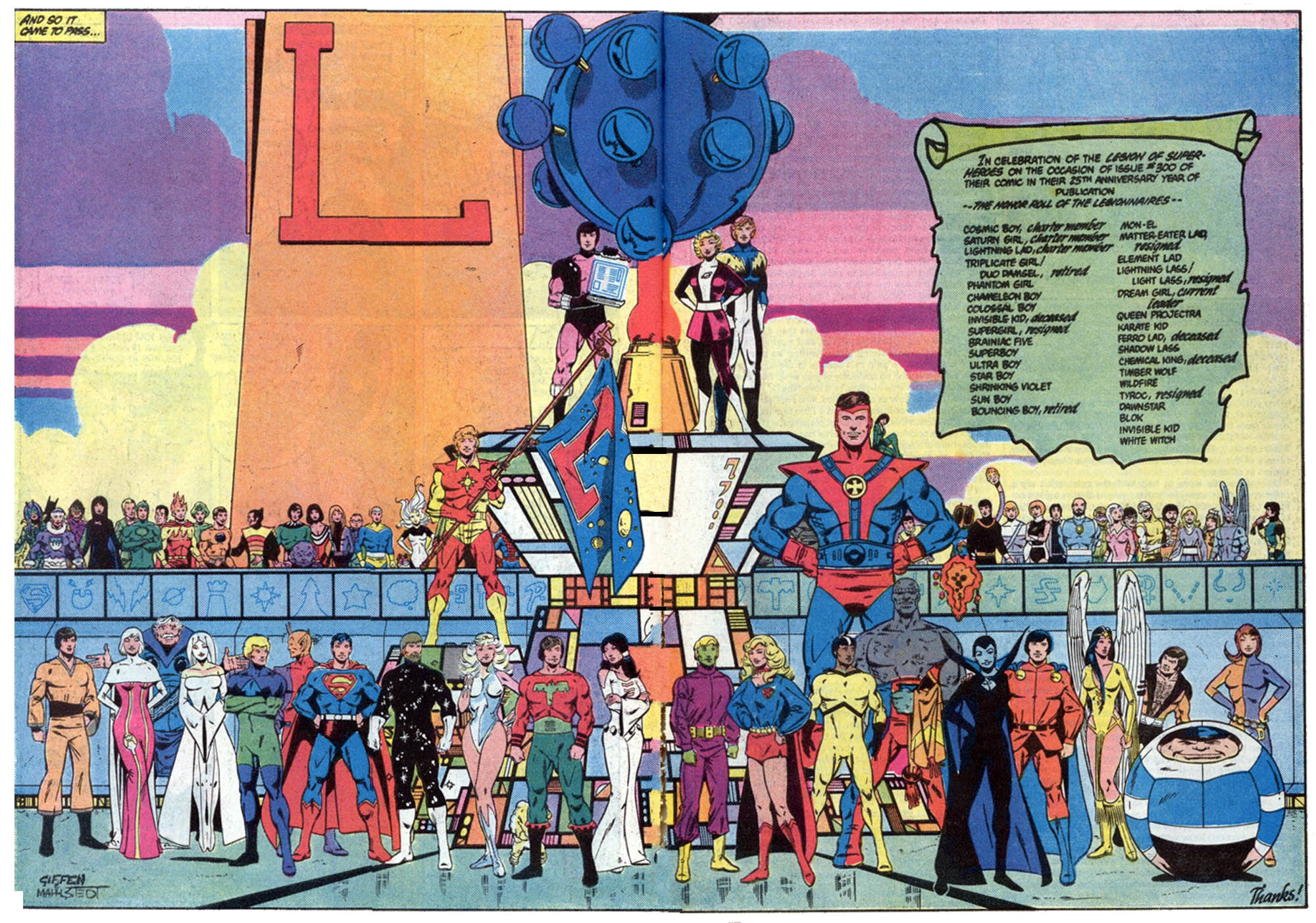
From Issue #300. Art by Giffen and Mahlstedt.
—
The American Comic Book Chronicles: The 1980s is available through TwoMorrows. Click here for more info.
—
MORE
— PAUL KUPPERBERG: My 13 Favorite PAUL LEVITZ Bronze Age Stories. Click here.
— PAUL KUPPERBERG: My 13 Favorite Pieces of KEITH GIFFEN Original Art. Click here.
—
NOTE: The original piece included footnotes that can be found in the book itself.

July 17, 2019
Great article! I love all of the pre-Zero Hour eras of the Legion, but the Grell and Giffen runs are my standout favorites.
Every time I see that new Legion cover at the top, I think that it looks like Proty lunging towards the flight ring instead of Superboy’s hand.
July 29, 2020
“A Cold and Lonely Corner of Hell” – the first Legion comic I ever read and (I think) the second comic I ever bought, after Adventure Comics 489. The art was so evocative. The cast of characters was so dramatic and complex. Even now, seeing that Keith Giffen artwork brings up the awe I felt as a 8- and 9-year-old in 1982.
October 21, 2021
My favorite period was Grell and earlier. Seeing as nothing new works for me, I might need to check this out.
October 22, 2021
For a while there, the Teen Titans and the Legion were DC’s power-house franchises, with the potential to rival the X-Men. But it really fell apart in the late 1980s, I think a combination of Crisis on Infinite Earths undermining the continuity of each title (Wonder Girl and Superboy respectively), the artistic powerhouses moving on (Perez on the Titans and first Giffen then Lightle on LSH), and the remaining writers (Wolfman and Levitz) not having a strong collaborator, editorial or artistic, to bounce ideas off of.
October 23, 2021
My favorite couldn’t wait for the next issue 2come out @ the time
October 13, 2023
Really sad about Keith dying. My first Giffen comic was Defenders 49 that Mike Royer inked. Loved his stuff and loved all the different styles he used. A tremendous talent. RIP.
October 21, 2024
The 80s had lots of superteams. This was the best – a whole world created. It had the visual beauty of Teen Titans and X-Men, but Levitz was a better writer. It helped that it did not have to interact with the rest of the line as it was set in the future.-